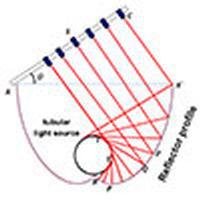当前位置:
X-MOL 学术
›
Adv. Opt. Photon.
›
论文详情
Our official English website, www.x-mol.net, welcomes your feedback! (Note: you will need to create a separate account there.)
Nonimaging optics: a tutorial
Advances in Optics and Photonics ( IF 27.1 ) Pub Date : 2018-05-24 , DOI: 10.1364/aop.10.000484 Roland Winston , Lun Jiang , Melissa Ricketts
Advances in Optics and Photonics ( IF 27.1 ) Pub Date : 2018-05-24 , DOI: 10.1364/aop.10.000484 Roland Winston , Lun Jiang , Melissa Ricketts

|
Nonimaging optics is the theory of thermodynamically efficient optics and as such, depends more on thermodynamics than on optics. Historically, nonimaging optics that work as ideal concentrators have been discovered through such heuristic ideas as “edge ray involutes,” “string method,” “simultaneous multiple surface,” and “tailored edge ray concentrator,” without a consistent theoretical definition of what “ideal” means. In this tutorial, we provide a thermodynamic perspective of nonimaging optical designs to shine light on the commonality of all these designing ideas, or what “ideal” nonimaging design means. Hence, in this paper, a condition for the “best” design is proposed based purely on thermodynamic arguments, which we believe have profound consequences. Thermodynamics may also be the most intuitive way for a reader who is new to this subject to understand or study it within a certain framework, instead of learning from sporadic designing methodologies. This way of looking at the problem of efficient concentration and illumination depends on probabilities, the ingredients of entropy, and information theory, while “optics” in the conventional sense recedes into the background. We attempt to link the key concept of nonimaging optics, etendue, with the radiative heat transfer concept of view factor, which may be more familiar to some readers. However, we do not want to limit the readers to a single thermodynamic understanding of this subject. Therefore, two alternative perspectives of nonimaging optics will also be introduced and used throughout the tutorial: the definition of a nonimaging optics design according to the Hilbert integral, and the phase space analysis of the ideal design. The tutorial will be organized as follows: Section 1 highlights the difference between nonimaging and imaging optics, Section 2 describes the thermodynamic understanding of nonimaging optics, Section 3 presents the alternative phase space representation of nonimaging optics, Section 4 describes the most basic nonimaging designs using Hottel’s strings, Section 5 discusses the geometric flow line designing method, and Section 6 summarizes the various concepts of nonimaging optics.
中文翻译:

非成像光学:教程
非成像光学是热力学高效光学的理论,因此更多地依赖于热力学而不是光学。从历史上看,作为理想集中器工作的非成像光学器件是通过诸如“边缘光线渐开线”、“弦法”、“同时多重表面”和“定制边缘光线集中器”等启发式思想发现的,但没有一致的理论定义“理想”的意思。在本教程中,我们提供了非成像光学设计的热力学视角,以阐明所有这些设计理念的共性,或者“理想”非成像设计的含义。因此,在本文中,纯粹基于热力学论证提出了“最佳”设计的条件,我们认为这会产生深远的影响。对于不熟悉该主题的读者来说,热力学也可能是在特定框架内理解或研究它的最直观方式,而不是从零星的设计方法中学习。这种看待有效集中和照明问题的方式取决于概率、熵的成分和信息论,而传统意义上的“光学”则退居幕后。我们试图将非成像光学的关键概念,集光率,与辐射热传递的视角因子概念联系起来,这对于一些读者来说可能更熟悉。但是,我们不想将读者限制在对该主题的单一热力学理解上。因此,本教程还将介绍和使用非成像光学的两种替代观点:根据希尔伯特积分定义非成像光学设计,以及理想设计的相空间分析。本教程将按如下方式组织:第 1 节重点介绍非成像光学和成像光学之间的区别,第 2 节描述了非成像光学的热力学理解,第 3 节介绍了非成像光学的替代相空间表示,第 4 节描述了最基本的非成像设计,使用Hottel 的字符串,第 5 节讨论了几何流线设计方法,第 6 节总结了非成像光学的各种概念。
更新日期:2018-05-24
中文翻译:

非成像光学:教程
非成像光学是热力学高效光学的理论,因此更多地依赖于热力学而不是光学。从历史上看,作为理想集中器工作的非成像光学器件是通过诸如“边缘光线渐开线”、“弦法”、“同时多重表面”和“定制边缘光线集中器”等启发式思想发现的,但没有一致的理论定义“理想”的意思。在本教程中,我们提供了非成像光学设计的热力学视角,以阐明所有这些设计理念的共性,或者“理想”非成像设计的含义。因此,在本文中,纯粹基于热力学论证提出了“最佳”设计的条件,我们认为这会产生深远的影响。对于不熟悉该主题的读者来说,热力学也可能是在特定框架内理解或研究它的最直观方式,而不是从零星的设计方法中学习。这种看待有效集中和照明问题的方式取决于概率、熵的成分和信息论,而传统意义上的“光学”则退居幕后。我们试图将非成像光学的关键概念,集光率,与辐射热传递的视角因子概念联系起来,这对于一些读者来说可能更熟悉。但是,我们不想将读者限制在对该主题的单一热力学理解上。因此,本教程还将介绍和使用非成像光学的两种替代观点:根据希尔伯特积分定义非成像光学设计,以及理想设计的相空间分析。本教程将按如下方式组织:第 1 节重点介绍非成像光学和成像光学之间的区别,第 2 节描述了非成像光学的热力学理解,第 3 节介绍了非成像光学的替代相空间表示,第 4 节描述了最基本的非成像设计,使用Hottel 的字符串,第 5 节讨论了几何流线设计方法,第 6 节总结了非成像光学的各种概念。



























 京公网安备 11010802027423号
京公网安备 11010802027423号